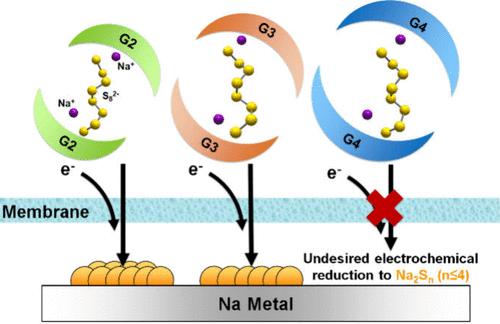当前位置:
X-MOL 学术
›
ACS Energy Lett.
›
论文详情
Our official English website, www.x-mol.net, welcomes your
feedback! (Note: you will need to create a separate account there.)
Optimizing Nonaqueous Sodium–Polysulfide Redox-Flow Batteries: The Role of Solvation Effects with Glyme Solvents
ACS Energy Letters ( IF 19.3 ) Pub Date : 2024-11-08 , DOI: 10.1021/acsenergylett.4c02113 Wenda Wu, Michelle Lehmann, Yuanshun Li, Lei Cheng, Guang Yang
ACS Energy Letters ( IF 19.3 ) Pub Date : 2024-11-08 , DOI: 10.1021/acsenergylett.4c02113 Wenda Wu, Michelle Lehmann, Yuanshun Li, Lei Cheng, Guang Yang

|
Nonaqueous redox-flow batteries (NARFBs) that use economical alkali metals and the corresponding metal polysulfides are highly attractive for grid-scale energy storage. Although sodium–sulfur systems have been recognized as promising candidates and have been the focus of many studies due to their high earth abundance and energy density, an understanding of the role of the solvation chemistry of commonly used glyme solvents is missing. Herein, we report a systematic investigation into the solvation effects of glyme-based Na-S electrolytes through comprehensive physiochemical experiments and Density Functional Theory (DFT) simulations. Our findings revealed, on one hand, that an optimal coordination strength between glymes and Na+ could maintain a relatively smooth Na+ diffusion. On the other hand, glyme solvents with extended chain lengths shift the reduction potential of S82– negatively to elevate the formation barrier of undesirable short-chain polysulfides (Sn2–, n ≤ 4) that have high membrane permeability. This solvation phenomenon not only mitigates capacity fading but also extends the operational longevity of the Na-S NARFBs. The results underscore the critical roles of balanced solvent–cation interactions and controlled redox potentials in improving the stability and efficiency of Na-S NARFB systems, marking a significant advancement in the development of sustainable energy storage solutions.
中文翻译:

优化非水性钠-多硫化物氧化还原液流电池:Glyme 溶剂溶剂溶剂化效应的作用
使用经济碱金属和相应金属多硫化物的非水氧化还原液流电池 (NARFB) 对电网规模的储能极具吸引力。尽管钠硫体系已被公认为有前途的候选者,并且由于其高地球丰度和能量密度而成为许多研究的重点,但对常用 Glyme 溶剂的溶剂化化学作用的理解仍然存在。在此,我们报告了通过综合理化实验和密度泛函理论 (DFT) 模拟对基于钱氨酸的 Na-S 电解质的溶剂化效应的系统研究。我们的研究结果一方面揭示了鸢扬素和 Na+ 之间的最佳配位强度可以保持相对平滑的 Na+ 扩散。另一方面,具有长链长度的钞蒲溶剂会负向改变 S82– 的还原电位,从而提高具有高膜通透性的不良短链多硫化物(Sn2–、n ≤ 4)的形成屏障。这种溶剂化现象不仅减轻了容量衰减,还延长了 Na-S NARFB 的使用寿命。结果强调了平衡溶剂-阳离子相互作用和受控氧化还原电位在提高 Na-S NARFB 系统的稳定性和效率方面的关键作用,标志着可持续储能解决方案的开发取得了重大进展。
更新日期:2024-11-09
中文翻译:

优化非水性钠-多硫化物氧化还原液流电池:Glyme 溶剂溶剂溶剂化效应的作用
使用经济碱金属和相应金属多硫化物的非水氧化还原液流电池 (NARFB) 对电网规模的储能极具吸引力。尽管钠硫体系已被公认为有前途的候选者,并且由于其高地球丰度和能量密度而成为许多研究的重点,但对常用 Glyme 溶剂的溶剂化化学作用的理解仍然存在。在此,我们报告了通过综合理化实验和密度泛函理论 (DFT) 模拟对基于钱氨酸的 Na-S 电解质的溶剂化效应的系统研究。我们的研究结果一方面揭示了鸢扬素和 Na+ 之间的最佳配位强度可以保持相对平滑的 Na+ 扩散。另一方面,具有长链长度的钞蒲溶剂会负向改变 S82– 的还原电位,从而提高具有高膜通透性的不良短链多硫化物(Sn2–、n ≤ 4)的形成屏障。这种溶剂化现象不仅减轻了容量衰减,还延长了 Na-S NARFB 的使用寿命。结果强调了平衡溶剂-阳离子相互作用和受控氧化还原电位在提高 Na-S NARFB 系统的稳定性和效率方面的关键作用,标志着可持续储能解决方案的开发取得了重大进展。


















































 京公网安备 11010802027423号
京公网安备 11010802027423号